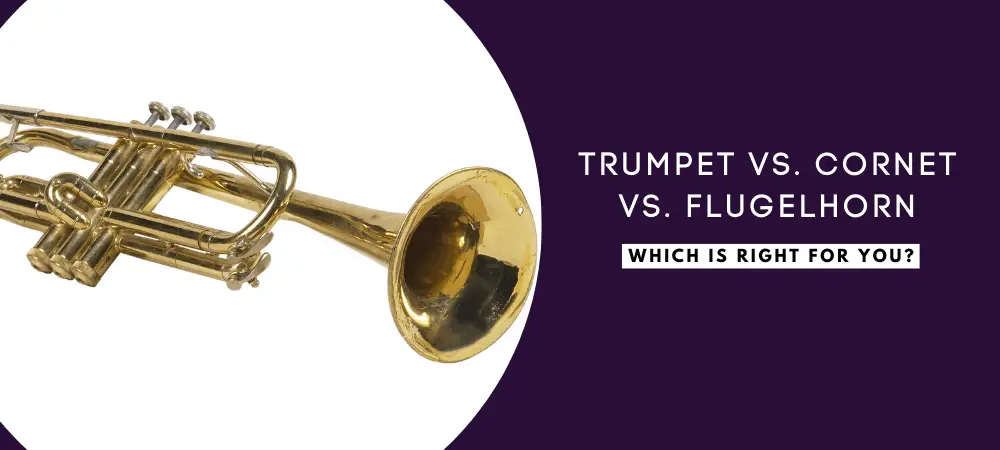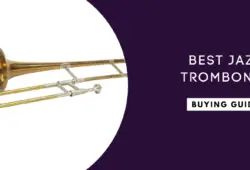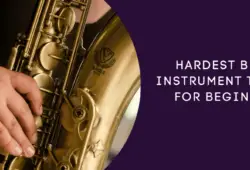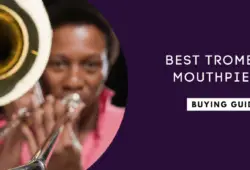All three; the Cornet, Flugelhorn, and Trumpet are members of the brass instruments family.
But even then, just like family members possess different attributes, they too release various sound qualities when played.
Therefore, if you and your friends are considering forming a band or you want to experiment with your creative side by venturing into orchestral writing, then it’s advisable to know the differences so that you invest well.
Today, we take you through an in-depth comparison of these three incredible musical instruments, to help you be on the know-how.
However, before that, it’s good to understand each instrument;
Table of Contents
Trumpet
As already mentioned in the introduction, the trumpet is a musical instrument categorized under the brass family.
It’s tuning is usually Key B flat, which makes it a perfect tool for jazz and classical performers.
Due to its ease nature of use, the trumpet is the most commonly used in its category.
This beautiful musical instrument rose to fame in ancient times when it was majorly used as a signal tool between hunters and war armies.
With the passage of time and the beginning of the revolution, the trumpet was finally tried out and recognized as a musical instrument in the 14th century.
And its use has since then been on the rise, as organizers and performers of jazz, concert, and orchestras included it in their preferred musical instrument tools.
To play the trumpet, the player first needs to learn how to embouchure (position their lips).
Afterward, it’s pretty simple to learn, but that doesn’t spare users little difficulties here and there.
But, everything is possible with patient and dedication, right?
Cornet
The cornet also belongs to the brass family.
It contains a cup-shaped mouthpiece and its history goes back to the 15th century and has since been around up to the end of the 19th century when its popularity went down.
If we were comparing families, then the cornet fits perfectly into the title of the trumpet’s “little cousin”, measuring at 4 ½ ft.
It’s believed to have been used first by Jean-Louis Antoine and was popularly used in Paris in the 1820s before spreading to the rest of the world.
The 19th century saw the invention of various variations of the Cornet some of which were referred to as; the circular cornet, the echo cornet, and the butterfly cornet.
The cornet is easy to play, especially for individuals who have already tried out the trumpet.
Flugelhorn
This brass family musical instrument is pretty similar to the Cornet.
But, it comes with a little wider conical bore, which makes it easier to differentiate, though it might be difficult for beginners to notice the differences.
It’s designed to produce flat-B tones, with some releasing some C tones and has three valves.
The name Flugelhorn is of German origin and it means “flank horn” or “wing horn”.
It has the same tube length with the trumpet, thus a little bigger than the cornet.
The concept behind the invention of the Flugelhorn from the English valveless bugle.
Trumpet vs Cornet vs Flugelhorn: Comparison
Shapes: Conical vs. Cylindrical
Any brass musical instrument with a conical shape tends to release warmer tones, which are usually characterized by a little upper harmonics.
But, one that displays a cylindrical bore, tends to release stronger tones, which are attributed to more upper harmonics.
According to an ancient musical instruments formulae, which used to help performers understand the important relationship between various instruments;
- The Trumpet is around 2/3 cylindrical and about 1/3 conical
- The Flugelhorn is about 1/3 cylindrical and around 2/3 conical
- And lastly, the Cornet tends to be ½ cylindrical and about ½ conical.
So, this should give you a rough idea about the shapes of these three brass instruments.
And although most of the trumpets we see today exhibit partial conical attributes through their expected cylindrical bore, it’s a reality that we have to get accustomed to, due to changes that come with time.
Mouthpieces Comparison
The design of the mouthpiece of these three brass musical instruments is important in depicting their differences.
Although we cannot dictate how various designers work, and cannot expect them to bring forth 100% similar tools, the industry has some set standard designing rules that have to be followed.
For example, for Trumpets, their makers are expected to create instruments that contain cup-shaped mouthpieces.
And for that, the interior part of the Trumpet mouthpieces have to be carefully shaped into a standard teacup, but complete with a c-shaped bowl.
For better understanding, compare the Trumpet’s mouthpiece with that of a horn (yes, it also belongs to the brass family), which is its complete opposite.
The horn’s mouthpiece tends to be funnel-shaped, with no bowl in the middle.
In the .music instruments’ sector, we normally say that the deeper the cup, the warmer the tone it produces, and vice-versa.
So, when it’s shallow, like that one of the Trumpet, its tome is more brilliant.
On the other hand, the original Cornets’ mouth-pieces were funnel-shaped.
But with time, some “corruption” took place and some designers started to create cup-shaped mouthpieces for this instrument.
And this is one of the reasons, the Cornet, rapidly lost its true magical sound.
Now, still, on the brass family and directing our attention to the Flugelhorn mouthpieces, they were originally created to be very similar to the funnel-shaped mouthpieces of the Cornet.
And they still proudly exhibit those deep funnel cup endings.
But even then, they aren’t anything like the Cornet, because the mouthpiece diameter of their leading pipe is far much different from that of the Cornet.
History: Trumpet vs. Cornet vs. Flugelhorn
The trumpet might presently be the most famous soprano musical instrument in the brass family, but if legends could speak, they will tell you that it’s the cornet that dominated in band performances, in the last century.
Those were the days that Trumpets made grand entrances in orchestras and their limelight used to linger only on those stagers.
This is because, according to this Herbert L. Clarke letter, it had the much-needed capability to meet the needs of a large orchestra, with 60 and more attendees.
In fact, history indicates that most school bands in the US in the 1960s possessed more cornets than trumpets.
In this case, the Cornets were usually allocated the technical flowery tunes, with the Trumpets (known as F Tromba in those days) settling to adding punctuations to the music to make it come out brilliantly.
So, throughout the 19th century, the Trumpet and the cornet managed to coexist peacefully. And each enjoyed their distinct sounds.
However, with time, the trumpeters started realizing how easy it was for Cornet performers to play.
And as they built friendships and exchanged instruments from time to time, most trumpets, begun preferring exchanging their Trumpets for cornets.
That’s how their Tromba, became small and quickly transformed to the Trumpet we know today.
And that’s how these performers started to twist the attributes of the cornet, making it burly year after year, until the cornet was barely noticeable over the years.
But even with all this assimilation, the Flugelhorn had strong features that made it stand out. And it wasn’t easy to transform it (much), so it managed to retain its identity as we know it even today.
And although the Flugelhorn has also undergone some changes, they are only meant to make it better. And that’s why you can easily notice that the modern version is extremely soprano tuba, with impressive high conical bore shape.
Popularity: Which is More Popular?
The Trumpet is the most played of these three brass instruments, and because of this exposure, it’s the most popular.
So typically, more production of trumpets take place worldwide as compared to the Cornet and Flugelhorn.
And one of the major reasons for this is because Brass bands are most famous in British ensembles, while Trumpets remain the most preferred in the American Market, where live performances are most embraced.
But recently, the use of cornets and Flugelhorn have been on the rise, especially in Asian countries, Australia and even America.
And if the trend continues like this, then we can expect the popularity gap between trumpet and the other two brass cousins to narrow down.
But as for now, Trumpets carry the popularity trophy, followed closely by the modern-day cornets and then the Flugelhorn.
Also, with the Chinese musical instruments coming out in better quality and affordable prices, the musical scene is about to witness a makeover, which will predictably continue to narrow down the dominance of the Trumpet.
Age Preference: Which Is Better For Your Kid?
First, we would like you to understand that most of the famous Trumpet players, started their lessons using Cornets.
This is because Cornets are smaller, thus offering an easier hold to younger children as compared to the large nature of Trumpets.
Yes, today’s trumpet and Cornet might be similar in length, but when you closely look at the tubing, you will realize that Cornets have theirs wrapped tightly, thus making them more comfortable for kids.
On the other hand, Flugelhorn is a bit complex to use, thus it is popular among older experienced players, than young children.
FAQs About Comparison between Trumpet vs Cornet vs Flugelhorn
Is cornet easier than trumpet?
Unlike in the past century where there were distinct features between the cornet and the trumpet, presently, trying to differentiate the two is like comparing “twin” sisters.
They’re practically the same instrument.
Still, there are some differences like for example, the tubing of the trumpet is cylindrical, while that of the cornet is conical.
But even then, they take exactly the same energy and dedication to learn, at the same score.
And even if the trumpet is brighter and the cornet mellower, they really don’t matter to a beginner, as you will start placing count into that when you’re a little bit advanced.
So, the best thing to do is head to the store, test them both and purchase one that’s closest to your preference.
Note; it’s, however, important to note that, the cornet’s shape makes it a bit easier to play, in the beginning. This’s mainly because of the tight wrap, which places it closer to one’s body.
And this makes it comfortable for younger players.
Is flugelhorn harder than trumpet?
Playing the flugelhorn is different to play as compared to a trumpet.
And the rate of difficulty actually depends from individual to individual.
While some of them might find the flugelhorn as easy-different, others find it harder-different.
However, generally, toning when using a flugelhorn isn’t as demanding as in Trumpet.
But it requires a lot of concentration, as you will have to learn to take in a different amount of air.
So, when you’re feeling worn-out, it’s better to play the trumpet.
Flugelhorn vs. French horn: differences
- The French horn is rounder than the flugelhorn
- Physically, the flugelhorn appears like a large trumpet, and the French horn looks nothing like that.
- The sound of the French horn is more brassier as compared to that of the flugelhorn
- You can play the French horn in key For Bb, depending on how you want the sound to come out. But, the flugelhorn can only play key B-flat and sometimes C.
- When using a French horn, you have to write a 5th higher than your desired pitch. But, with the flugelhorn, you can only write a major 2nd higher than your desired sound pitch and you will be good to go.
Conclusion
The Trumpet, Flugelhorn, and Trumpet can be played at the same event and by a particular performer.
And although they complement each other well, they belong to various brass instruments families, which means they possess distinct differences and of course similarities.
In this article, however, we focused on the comparison with more information on notable differences.
This is important information for upcoming bands and individuals with an interest in these types of musical instruments.
We therefore hope, you got all the useful information you have been searching for.
And it’s our wish to continue writing useful articles for you. So, if you there’s anything we forgot to mention, feel free to add in the comment section.
Remember, we value your feedback, always.




